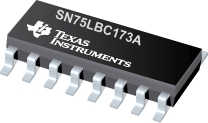

SN75LBC173A是TI公司的一款无产品,SN75LBC173A是四路 RS-485 差动线路接收器,本页介绍了SN75LBC173A的产品说明、应用、特性等,并给出了与SN75LBC173A相关的TI元器件型号供参考。
SN75LBC173A - 四路 RS-485 差动线路接收器 - 无 - RS-485收发器 - TI公司(Texas Instruments,德州仪器)
The SN65LBC173A and SN75LBC173A are quadruple differential line receivers with 3-state outputs, designed for TIA/EIA-485 (RS-485), TIA/EIA-422 (RS-422), and ISO 8482 (Euro RS-485) applications.
These devices are optimized for balanced multipoint bus communication at data rates up to and exceeding 50 million bits per second. The transmission media may be twisted-pair cables, printed-circuit board traces, or backplanes. The ultimate rate and distance of data transfer is dependent upon the attenuation characteristics of the media and the noise coupling to the environment.
Each receiver operates over a wide range of positive and negative common-mode input voltages, and features ESD protection to 6 kV, making it suitable for high-speed multipoint data transmission applications in harsh environments. These devices are designed using LinBiCMOS™, facilitating low power consumption and robustness.
The G and G\ inputs provide enable control logic for either positive- or negative-logic enabling all four drivers. When disabled or powered off, the receiver inputs present a high-impedance to the bus for reduced system loading.
The SN75LBC173A is characterized for operation over the temperature range of 0°C to 70°C. The SN65LBC173A is characterized over the temperature range from -40°C to 85°C
- Designed for TIA/EIA-485, TIA/EIA-422, and ISO 8482 Applications
- Signaling Rate Exceeding 50 Mbps
- Fail-Safe in Bus Short-Circuit, Open-Circuit, and Idle-Bus Conditions
- ESD Protection on Bus Inputs Exceeds 6kV
- Common-Mode Bus Input Range -7 V to 12 V
- Propagation Delay Times <16 ns
- Low Standby Power Consumption <20 µA
- Pin-Compatible Upgrade for AM26LS32, DS96F173, LTC488, and SN75173
LinBiCMOS is a trademark of Texas Instruments. The signaling rate of a line is the number of voltage transitions that are made per second expressed in the units bps (bits per second).







